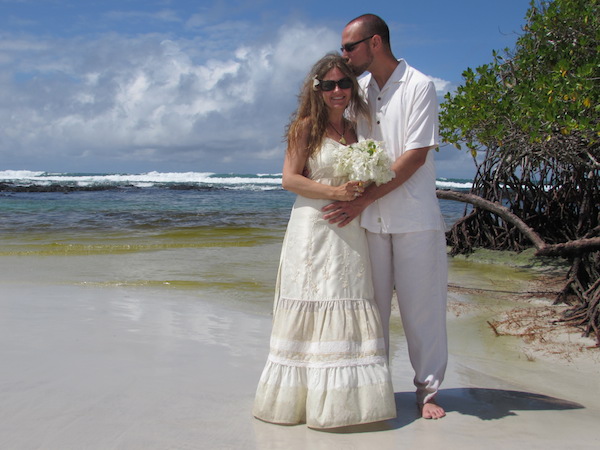I am the luckiest girl in the world.
This is my 19th trip to Peru, and the best one yet…my honeymoon! Paul and I were married on a sandy beach in the Galapagos Islands, our tiny ceremony attended only by close friends, a black-tip reef shark and a mess of curious marine iguanas. Now here I am sharing another remarkable place, my home away from home, with the love of my life. It is his first visit, making this one all the more exciting for me.
Every year, millions of tourists come hustling through Peru to check off the quintessential bucket-list destinations of Machu Picchu and the Peruvian Amazon. As spectacular as these places are, it is the life-changing culture and scenery surrounding them that keep me coming back time and again. Most travelers will only get one chance to see Peru…it is a shame to think that so many of them will speed right past the juiciest parts!
We begin our luna de miel on the stony shores of Lake Titicaca, on a remote peninsula twenty miles from the Floating Islands of Uros, at a stunning waterside lodge. There are sheep and long-haired donkeys everywhere. We spend intimate time with three generations of a single family of traditional weavers in the village of Copamaya, who dress us in traditional wedding garb and kiss our faces when we leave. Next, we sail the choppy Titicaca water to reach the island of Taquile, a sanctuary of Andean history that seems frozen in time. Here, knitting is the way to a woman’s heart and the locals still speak Quechua. Of course, we are bemused to find one of them speaking it into a cellular phone!
The next leg of our trip is my all-world favorite, the timeless mountain stronghold of Cusco. Perched upon the dragon’s teeth of the Andes, Cusco is a city of layers. The Inca built their capital on the bones left behind by their mysterious predecessors. The Spanish destroyed their temples, and left behind a romantic labyrinth of cobblestone streets, clay tiles and European arches. Every doorway is a history lesson, whether carved in wood or wrought in iron, or simply a woven blanket flapping in the breeze. The Plaza de Armas is always buzzing with activity, and bursting with the exotic smells of Peruvian culture and cuisine…sweet-smelling flowers and fruits, roasting corn, charred guinea pigs. And of course, the comforting smells of tourist-focused pizzerias and burger joints.
Too soon, we are following the winding road away from Cusco. We have a guide now, a Cusco native with roots in the community and a passion for his peoples’ history. We take our time on the quiet road. Wilfredo beams with pride as he describes the Andean tradition of pachamanquero cooking, wherein the farmers bury potatoes and maybe fresh trout in a pit of clay and stone and embers. Lunch cooks slowly in the earth as the farmers work all day, and a circle continues.
Wilfredo leads us to a nondescript rock formation, just off the cultured stone and grass trail of the King’s Road of the Incas. A doorway hidden in the rock face leads us into the sacred cave known as the Temple of the Moon. For centuries, farmers have made offerings here to the fertility goddess Pachamama on an altar of smooth stone. Barefoot, Paul and I climb onto the altar and hold hands as we bathe in the soft glow of the natural skylight above it, and all is right in the world.
The road winds on, and it feels almost like the mountain passes of our Colorado home…until all at once the Sacred Valley of the Incas opens up before us, the mighty Urubamba River kissing the craggy faces of the mountains on first one side, and then the other. The valley floor is a patchwork quilt of farm plots, quinoa and corn and crops of every kind. Ancient terraces peer down at us from the hills. We feel a deep yearning to leave it all behind, to put down roots and raise bees in this glowing golden cradle of all things nourishing.
In many ways, the Valley belongs to tourism now. But if you take the time to dig a little deeper, to linger a little longer, you will find a passionate and peaceful people with a feverish and loving grasp on their history and traditions. You will find the brilliant salt pans of Maras, and the ingenious agricultural laboratory of Moray. There are llamas and flowers and waterfalls. The boutique hotels here are a traveler’s dream, luxurious and organic and built as if they belonged here. The locals are full of hope and wisdom, like flowers nourished by the sun.
Wilfredo says he has hiked the Inca Trail more than 400 times. Rosa is our guide from the Sacred Valley onward, and one of my dearest friends. She too has been exploring these ruins for a lifetime, and has been my guide here many times before. Paul is transfixed by her accounts of Inca history and Peruvian culture. She teaches him about the philosophy of the Incas, a centuries-early love affair with peace and bio-diversity, a culture of sharing and of teamwork. She prepares us for the deeper meaning of Machu Picchu, the hidden beauty beyond the photo opportunities. We have already found serenity, and we are only now approaching mankind’s greatest monument to community, and to sustainable living.
I am the luckiest girl in the world.





